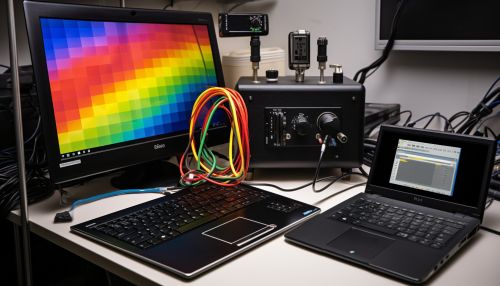Absorption spectroscopy
Introduction
Absorption spectroscopy refers to spectroscopic techniques that measure the absorption of radiation, as a function of frequency or wavelength, due to its interaction with a sample. The sample absorbs energy, i.e., photons, from the radiating field. The intensity of the absorption varies as a function of frequency, and this variation is the absorption spectrum. Absorption spectroscopy is performed across the electromagnetic spectrumElectromagnetic Spectrum.
Principles of Absorption Spectroscopy
Absorption spectroscopy works on the principle of the absorption of light or other electromagnetic radiation by atoms or molecules. This absorption happens when the energy of the photons matches the energy difference between two quantum states of the atoms or molecules. The absorbed energy can be used to promote electrons to higher energy levels, to break bonds, or to excite vibrational or rotational states.
Types of Absorption Spectroscopy
There are several types of absorption spectroscopy, including ultraviolet-visible (UV-Vis) spectroscopyUV-Vis Spectroscopy, infrared (IR) spectroscopyInfrared Spectroscopy, and X-ray absorption spectroscopyX-ray Absorption Spectroscopy.
Ultraviolet-Visible (UV-Vis) Spectroscopy
UV-Vis spectroscopy involves the spectroscopy of photons in the UV-Vis region. It uses light in the visible and adjacent (near-UV and near-infrared (NIR)) ranges. The absorption or reflectance in the visible range directly affects the perceived color of the chemicals involved.
Infrared (IR) Spectroscopy
IR spectroscopy is the spectroscopy that deals with the infrared region of the electromagnetic spectrum. It covers a range of techniques, mostly based on absorption spectroscopy. As with all spectroscopic techniques, it can be used to identify and study chemicals.
X-ray Absorption Spectroscopy
X-ray absorption spectroscopy (XAS) is a widely used technique for determining the local geometric and/or electronic structure of matter. The experiment is usually performed at synchrotron radiation sources, which provide intense and tunable X-ray beams.
Applications of Absorption Spectroscopy
Absorption spectroscopy has many applications in various fields such as physics, chemistry, and astronomy. It is used to measure the concentration of a particular species in a sample, to identify molecules, and to study the internal structures of molecules.
Conclusion
Absorption spectroscopy is a powerful tool for understanding the interaction between light and matter. It has a wide range of applications in various scientific fields, and its principles form the basis of many analytical techniques.
See Also


